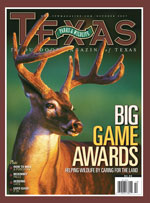
61 Years Ago in Texas Game and Fish
The now-abundant white-winged dove was on the verge of being wiped out in the 1940s.
By Jon Lucksinger
White-winged doves have long been a favorite game bird for Texas hunters, but in the early 1940s, concerns focused more on how to keep the birds alive than on how to kill or cook them. In response to a severe population decline, the Texas Game, Fish and Oyster Commission (predecessor of the Texas Parks and Wildlife Department) launched several initiatives — including shortened seasons and habitat restoration — that eventually led to the whitewing flourishing once again.
***
From the September 1946 issue of Texas Game and Fish:
Billions of White-winged Doves
The story of the white-winged dove is getting to be an old story to so many Texans. Even so, it is not being told enough. We are still fighting a losing battle in their conservation and too many people have not yet heard. If history repeats itself, the last whitewing could fall before a shotgun amid the clamoring voices of the too many hunters who will still be demanding a bigger bag limit and a longer season.
When your State Game Commission and the U.S. Fish and Wildlife Service initiated an extensive study of the white-wing’s status in 1939, we were set on discovering the factors that had caused a great reduction of the population in Texas. Substantial reports indicated that there had been a minimum of 5,000,000 birds about 1920 to compare with only a half million in the late 1930s. We have a reasonably complete picture now.
During the period involved, approximately 90 percent of the brushland used for nesting in the Rio Grande Valley was cleared for vegetable and fruit farming. Consequently, many thousands of birds found themselves without adequate breeding range.
The remaining nesting areas became highly congested. Concentrations of white-on wings ran as high as 500 pairs of birds per acre! Predators and disease found happy hunting in such an over-crowded population. Records on several thousand nests revealed that each pair of birds had to lay an average of five eggs before one squab could be raised to 15 days of age, at which time the young birds are barely old enough to leave the nest.
Hunting has increased annually as the population decreased and the popularity of the whitewing spread. From an unlimited season and an insignificant kill in early South Texas, we had an open season of only five half-days in 1945 and a kill of half of our birds in Texas! A cattleman with only 60 percent calf crop would not stay in business long if he sold 50 percent of his herd each year without respect to sex. It is the same story with whitewings.
We killed too many birds last year, about twice as many as we should if we now intend to regain some of our lost breeding stock. Do not forget, either, that nesting grounds are still being destroyed and that there is no practical way to stop it. Nor, as our experiments have shown, is it a simple matter to maintain effective control of the production of young, for our best efforts against nature in this ill-balanced respect give only minor returns. Winning in the fight to save the whitewings in the face of such odds will take more aid than we personally can give, but there is no question but that we can give more than in the past.
Editor’s note: This is the fourth installment in an eight-part series commemorating the 65th anniversary of Texas Parks & Wildlife magazine (formerly Texas Game and Fish).

